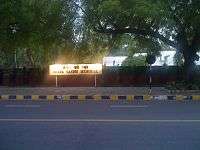Assassination of Indira Gandhi

Indira Gandhi, the 3rd Prime Minister of India, was assassinated at 09:20 on 31 October 1984, at her Safdarjung Road, New Delhi residence.[1][2] She was killed by two of her bodyguards,[3] Satwant Singh and Beant Singh, in the aftermath of Operation Blue Star, the Indian Army's June 1984 assault on the Golden Temple in Amritsar which left the Sikh temple heavily damaged.[4]
Assassination
At about 09:20 on 31 October 1984, Indira Gandhi was on her way to be interviewed by British actor Peter Ustinov, who was filming a documentary for Irish television. She was walking through the garden of the Prime Minister's Residence at No. 1, Safdarjung Road in New Delhi towards the neighbouring 1 Akbar Road office.[1]
As she passed a wicket gate guarded by Satwant Singh and Beant Singh, the two opened fire. Sub-Inspector Beant Singh fired three rounds into her abdomen from his sidearm.[5] Satwant Singh then fired 30 rounds from his Sten gun into her after she had fallen to the ground.[5] After the shooting, both threw their weapons down and Beant Singh said "I have done what I had to do. You do what you want to do." In the next six minutes Tarsem Singh Jamwal and Ram Saran, soldiers in the Indo-Tibetan Border Police, captured and killed Beant Singh in a separate room. Satwant Singh was arrested by Gandhi's other bodyguards along with an accomplice trying to escape, and was seriously wounded in the attack initiated by Beant Singh.[6] Satwant Singh was hanged in 1989 with accomplice Kehar Singh.[7]
Salma Sultan gave the first news of the assassination of Indira Gandhi on Doordarshan's evening news on 31 October 1984, more than 10 hours after she was shot.[8][9] It is alleged that R. K. Dhawan, Mrs. Gandhi's secretary, overruled intelligence and security officials who had ordered the removal of Sikh policemen, including her eventual assassins, as a security threat.[10]
Perpetrators Beant Singh was one of Gandhi's favorite guards, whom she had known for ten years.[5] The other assassin, Satwant Singh, was 22 years old when the assassination occurred and had been assigned to Gandhi's guard just five months before the assassination.[5]
Death
Indira Gandhi was brought at 09:30 to the All India Institute of Medical Sciences (AIIMS-New Delhi), where doctors operated on her. She was declared dead at 14:20. The postmortem examination was conducted by a team of doctors headed by T. D. Dogra. He stated that as many as 30 bullets struck Gandhi, from two sources, a Sten gun and a revolver. The assailants had fired 33 bullets at her, of which 30 had hit; 23 had passed through her body while seven were trapped inside. Dogra extricated bullets to establish the identity of the weapons and to correlate each weapon with the bullets recovered by ballistic examination. The bullets were matched with respective weapons at CFSL Delhi. Subsequently, Dogra appeared in the court of Shri Mahesh Chandra as an expert witness (PW-5). The cross-examination was conducted by Shri P. N. Lekhi, the defense counsel.[11] Her body was brought in a gun carriage through Delhi roads on the morning of 1 November to Teen Murti Bhawan where her father stayed, and where she lay in state.[1] She was cremated on 3 November, near Raj Ghat (a memorial to Mahatma Gandhi) at an area named Shakti Sthal. Her elder (and the then surviving) son and successor, Rajiv Gandhi, lit the funeral pyre.
Aftermath
Over the next four days, thousands of Sikhs were killed in retaliatory violence.
The Justice Thakkar Commission of Inquiry set up to probe Indira Gandhi's assassination recommended a separate probe for the conspiracy angle behind the assassination. The Thakkar Report stated that the "needle of suspicion" pointed at R.K. Dhawan for complicity in the conspiracy.
Satwant Singh and alleged conspirator Kehar Singh were sentenced to death. The sentence was carried out on 6 January 1989.
A Punjabi movie titled Kaum De Heere (translation: People's Diamonds) highlighting the role/lives of two guards that assassinated Gandhi was set to be released on 22 August 2014, but was banned by the Indian government.[12][13]
See also
References
- 1 2 3 "25 years after Indira Gandhi's assassination". CNN-IBN. 30 October 2009.
- ↑ "Assassination in India: A Leader of Will and Force; Indira Gandhi, Born to Politics, Left Her Own Imprint on India". The New York Times. 1 November 1984. Retrieved 23 January 2009.
- ↑ "1984: Assassination and revenge". BBC News. 31 October 1984. Archived from the original on 15 February 2009. Retrieved 23 January 2009.
- ↑ "1984: Indian prime minister shot dead". BBC News. 31 October 1984. Archived from the original on 17 January 2009. Retrieved 23 January 2009.
- 1 2 3 4 Smith, William E. (12 November 1984). "Indira Gandhi's assassination sparks a fearful round of sectarian violence". Time. Retrieved 19 January 2013.
- ↑ "Questions still surround Gandhi assassination". Times Daily. New Delhi. AP. 24 November 1984. Retrieved 19 January 2013.
- ↑ Dr. Sangat Kr. Singh, The Sikhs in History, p. 393
- ↑ "The riots that could not be televised". Indianexpress.com. 3 November 2009. Retrieved 31 March 2015.
- ↑ "We the eyeballs : Cover Story - India Today". Indiatoday.intoday.in. Retrieved 31 March 2015.
- ↑ Hazarika, Sanjoy (28 March 1989). "India Releases Stinging Report on Gandhi's Death". The New York Times.
- ↑ Raina Anupuma, Lalwani Sanjeev (2009). "Dr. Dogra's Expert Evidence in trial of assassination of Late Mrs Indira Gandhi, Prime Minister of India (Witness No. PW 5)". Indian Internet Journal of Forensic Medicine & Toxicology. Indianjournals.com. Retrieved 31 March 2015.
- ↑ "Centre blocks release of controversial film on Indira Gandhi's assassins 'Kaum de Heere' - The Times of India". Timesofindia.indiatimes.com. Retrieved 31 March 2015.
- ↑ "The Tribune, Chandigarh, India - Latest News". Tribuneindia.com. Retrieved 31 March 2015.